How to Start Your Online Store with Amazon Seller Central?

Entrepreneurs who own Shopify and WooCommerce stores compete with other players in tight corners. They must diversify their sales channels to ensure their businesses take a manageable hit.
Let’s take the example of Bob, a direct-to-customer merchant in the pet food industry.
Bob sells mouth-watering pet munchies that pet owners and their cuddly buddies adore. He uses his Shopify store to run his online business. His sales numbers are doing great. However, an increase in copycat competition resulted in a consistent drop in sales despite all his best efforts.
To improve his sales, Bob decides to include Amazon, the world’s leading e-commerce marketplace, as part of his multi-channel retail strategy.
However, like most merchants, he finds the platform a bit overwhelming and needs help figuring out Amazon Seller Central, the centralized command center, to run a business on Amazon. Ultimately, he’s left with a myriad of questions, such as:
Can I leverage Amazon to make a buck?
Will it be easy to use Amazon Seller Central and its features?
Can I market my products effectively using this platform? And so on.
These critical questions can make or break his newfound sales strategy. So, how can Robert & other merchants like him tackle these challenges?
To make things easy for Bob and other merchants like him, we’ve developed this quick guide on launching an online store with Amazon Seller Central, covering the navigational aspects and real-time strategies that can boost your sales on Amazon and improve your overall business health.
Contents
What is Amazon Seller Central?
How can Seller Central improve your online business?
How to Register in Amazon Seller Central?
How Do You Add Products on Amazon Seller Central?
How to manage seller-fulfilled orders in Amazon Seller Central (FBM)
How to create cases in Amazon Seller Central?
Optimizing Amazon Seller Central
How to increase sales on Amazon Seller Central?
Frequently Asked Questions
What is Amazon Seller Central?
Amazon Seller Central is a comprehensive management platform offered by Amazon that helps run and manage your online business on the world’s most-visited e-commerce site.
Think of Amazon Seller Central as a command center that allows you to control every aspect of your business: managing day-to-day sales, product advertisements, order management, inventory tracking, and more. It improves efficiency and adds less burden as you run multiple e-commerce platforms daily.
It also helps you generate reports of your sales data and transactions to analyze business performance and maintain robust customer relationships.
How can Seller Central improve your online business?
Boosts your brand's visibility
According to an insider intelligence report, more than 60% of US online shoppers begin their product research on Amazon. Listing your products here will increase the chances of customers finding your brand. Seller Central paves a way to do so quickly with less hassle. You can concentrate on your strategy while Seller Central gets your products in front of your potential customers.
Seller Central opens the door to Amazon’s Vine program, where reliable and trusted product reviewers leave reviews on your products. Positive reviews from certified reviewers will eliminate the decision fatigue for your potential customers, thus increasing the conversion rate for your products.
Helps build strong relationships with customers
Amazon Seller Central can help you build strong relationships with your customers. It provides a communication service to interact with the customers where you can resolve their queries instantly, exchange damaged products, initiate refunds, and also gain feedback on your products for future R&D. Not only does it help you build your brand’s reputation, but it also negates the technical complexity of setting up your chat support.

Enables perfect launch program
Amazon often comes with productive plans to encourage new sellers. Amazon's Perfect Launch program is one such initiative that helps new sellers ramp up their game within the first 90 days. You can access this program when you sign up for Amazon Seller Central. It has five selling programs that are listed below.
Brand Registry Enrollment
A+ content for product marketing enhancement.
Fulfillment by Amazon
Price offer automation
Sponsored campaigns, coupons, and deals
Amazon Brand Registry
Enrolling in an Amazon Brand Registry application on Amazon Seller Central is critical if you sell under your brand. It protects your brand, identities, and access to advanced reporting tools.
Here are three compelling reasons to use the Amazon Brand Registry scheme:
Protects your brand against product piracy.
When selling a product under their brand, most of you may have one primary concern: A random merchant may duplicate your products. Amazon is a fiercely competitive business, and with such a large seller base, hundreds go above and beyond to stay ahead.
Nonetheless, Amazon Brand Registry registers the trademark and grants sole ownership of the "Amazon Buy Box." As a result, you can contact Amazon seller assistance to request the removal of duplicated brand products.
Enhanced Control over Product Listings:
With the Amazon Brand Registry, brand owners have more control over their product listings on Amazon. They can create detailed and accurate product listings with high-quality images and descriptions. It ensures that customers receive accurate information about the brand's products, which can lead to higher customer satisfaction and fewer returns.
Access to Brand-Specific Tools:
Amazon provides brand owners access to specialized tools and reports that can help them protect their brand and monitor its performance. These tools include Brand Analytics, which offers insights into customer behavior and shopping trends related to your brand. Additionally, brand owners can use the Amazon Brand Registry to report and remove counterfeit listings and protect their intellectual property rights.
Amazon's tight algorithmic standards constrain regular sellers. The regulations are relaxed, however, through their Registry program, and a seller has total authority over the following:
The product's name
Product Specification
Product illustration
Using product IDs rather than UPCs and EANs
Control over who can sell your Brand
You can determine who can sell your products using Amazon's register feature. There are five sorts of eligible vendors:
Sellers that market their goods under their brand name
Manufacturers as sellers
Sellers that possess private-label brand
White-label product manufacturers
Sellers who are genuine distributors
A+ Content
Access to A+ content on Amazon Seller Central allows you to optimize your brand narrative with high-quality images and videos. It helps to increase user experience, leading to more conversions and traffic to your brand listings.
Fulfillment by Amazon (FBA)
As part of Seller Central’s perfect launch program, the FBA program lets you leverage its storage, shipping, and customer support capabilities. If you enroll in the program, your products qualify for Amazon Prime, and we deliver them free of charge to Prime customers within one or two business days, while non-Prime customers receive free standard delivery.
If you don’t use the FBA program, you will be responsible for end-to-end processes from storage to shipping, including handling the returns.
Price offer Automation
With Amazon Seller Central, you can automate your product pricing to stay ahead of your competitors. Automating pricing helps the merchants adjust the prices in individual stock-keeping units based on pre-conditioned limits. Sellers can set limits for the following attributes.
Competitive lowest prices
Competitive external prices
Sales Units
Competitive buy box
Advertising
Amazon Seller Central has an effective advertising tool to track your marketing efforts and give extensive reports. To help you achieve Perfect Launch, we offer New Seller Incentives, including 5% back on your first $1,000,000 in branded sales, credits to try cost-per-click (CPC) advertising or kickstart your product reviews, and more—plus discounted Prime shipping, storage, returns, and more with Fulfillment by Amazon. The sellers can spend it on either Amazon PPC or cost-per-click advertising.
Visit here to understand more about the Perfect Launch Program.
How to Register in Amazon Seller Central?
Registering on Amazon Seller Central is a mandatory step to start your online store on Amazon. Keeping your tax information, banking details, and credit card handy will simplify this process. Based on your projected sales volume, you can choose between two selling options, i.e., a professional selling plan and an individual selling plan.
Individual Selling Plan - This plan suits those with lower seller volumes and is doing it as a side hustle. It is free to register and use. Like other Amazon services, you will be charged a fixed $0.99 per sale as a selling fee, with no upfront charges.
Professional Selling Plan - This plan has a fixed charge of $39.99/per month, and there is no charge for the sale of each product. It’s the most popular and recommended plan for professional sellers and branded businesses. Those who sign up for this plan can access all the features of Amazon Seller Central. It gives you the feasibility of bulk uploading of products, inventory management, amazon advertising, advanced reporting tools, and API access for third-party integrations.
You can find Amazon seller's central prices and features here.
How Do You Add Products on Amazon Seller Central?
After signing up, the first thing you’d need to do is add your products to Amazon. Let us look at how to create a new product list and sell it under the existing Amazon listing.
Go to Inventory and click on Add a Product.
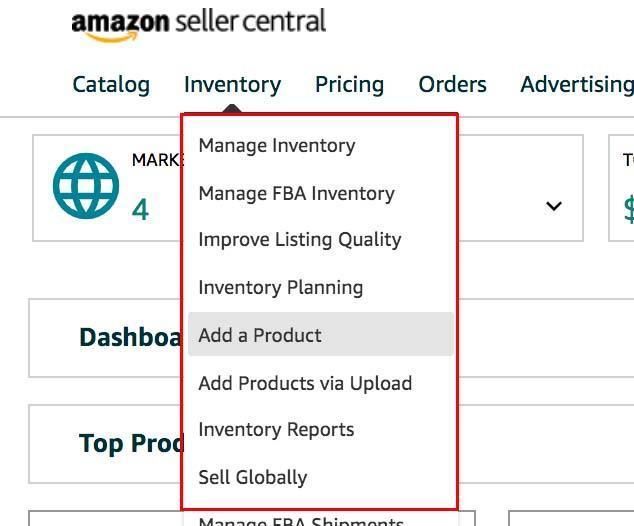
You will be redirected to the page shown below:

On this page, you have two options:
Adding a brand-new product
Reselling a product
Adding a Private Labeled Brand New Product:
Select this option to add a new product that is unavailable on Amazon.
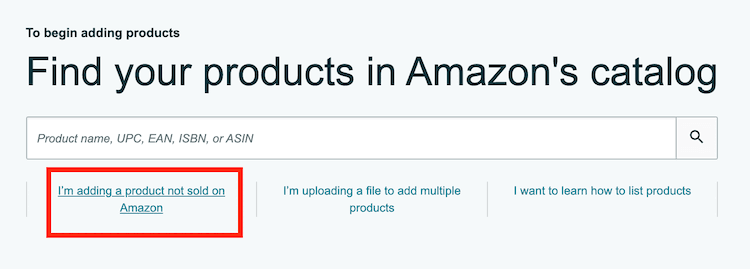
Here, you can search and select the category of product you want to add.
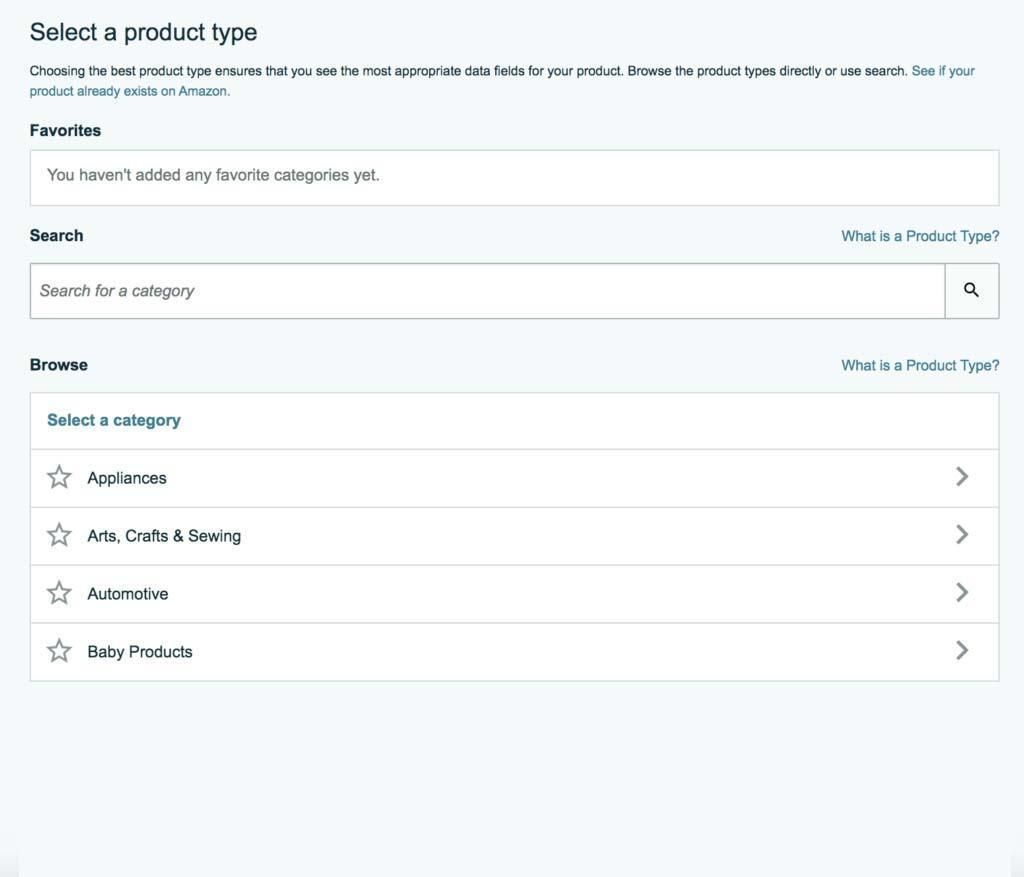
In the next screen, add the product details, such as product ID, Product Name, Brand name, and Product verification details, such as UPC, GTIN, EAN, and more.
You must wait for 24 - 48 hrs before listing your product. Amazon sells these product details against the GS1 database. If Amazon can’t find your product details in the GS1 database, it will not list your product.
If your product does not have UPC or other product verification details, apply for GTIN Exemption. Once Amazon completes your product verification and trusts your product, it will list the product.
For a product that doesn't have a UPC or GTIN number, you can apply for it on GS1.
Once your product is listed, you can enter the pricing and offer details as shown in the reselling product section.
Reselling a Product
When reselling a product that already exists on Amazon, it is easy to add the products. Enter any of the following details in the search box, i.e., UPC, Product name, EAN, etc.
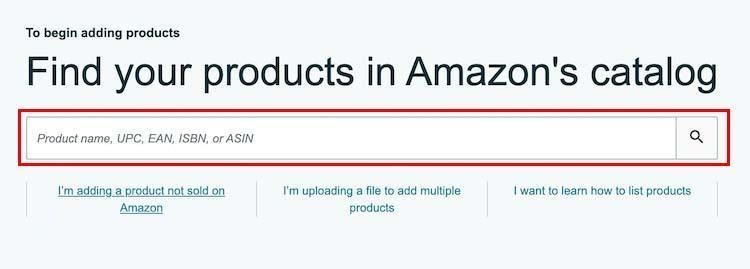
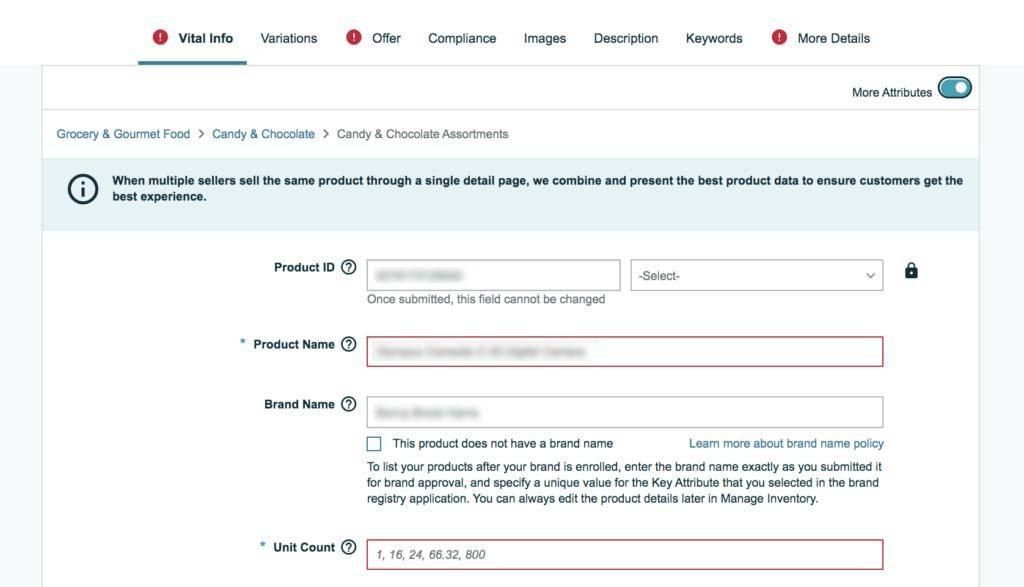
Once you find the product, click ‘Sell this product.’.

It will take you to the pricing offer information. You can fill in the details using Amazon FBA or FBM.

How do you change product prices on Amazon Seller Central?
In the Amazon Seller Center dashboard, click the Inventory tab and navigate to Manage Inventory.
You can find all the products in your inventory. Click the edit button for the product you want to edit the price.
In the next screen, edit the general information about the product. After that, the offer window will appear, and here, you can change the product’s price.
How Do You Access Advertising in Amazon Seller Central?
You may need to promote your product as an Amazon seller to increase sales. You can run ad campaigns for your products on Amazon's advertising console, and if enrolled in the Brand Registry, you can also generate Sponsored Display ads and Sponsored brand ads.
Under the "Advertising" option in Amazon Seller Central, select "Campaign Manager."
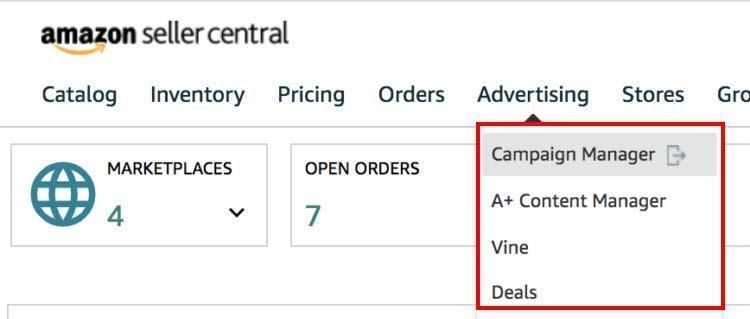
On the advertising console, review your current advertisements or create new ones.

How to manage seller-fulfilled orders in Amazon Seller Central (FBM)
You will be responsible for order fulfillment if you use FBM to list your items. After receiving an order, you must fulfill it by obtaining a shipping label and marking it as shipped in Seller Central.
Click "Manage Orders" under the "Orders" page to view your orders.
Here, you will see any unfulfilled FBM orders. Additionally, you can view your FBA orders in this section.

How do you get Amazon Attribution on Seller Central?
Amazon Attribution is a free advertising tool that allows brand-registered merchants to evaluate external advertising performance. This tool helps sellers identify which non-Amazon marketing methods work better for their business.
Attribution measures advertising efforts, search, social, video, and email marketing ROI. You'll learn how people find, investigate, and buy your items on Amazon.
Fill out a sign-up form or register through Seller Central if you're a seller or vendor. After setting up your Attribution account, you may add goods to track campaigns.
Creating an Attribution Tag:
The attribution tag is a tracking URL like Facebook or Google's tracking. The tag 'sticks' to a customer's complete product search journey, from clicking your external ad to reaching your Amazon listing, where they may or may not purchase.
Your external marketing campaign only needs the tracking URL. Under a Facebook ad, insert the Amazon Attribution link in "URL Parameters." The tag will generate consumer behavior data to influence ad selections.
Once signed in to Amazon Seller Central, go to Amazon Attribution.
Click "Create Campaign" to create a new campaign.
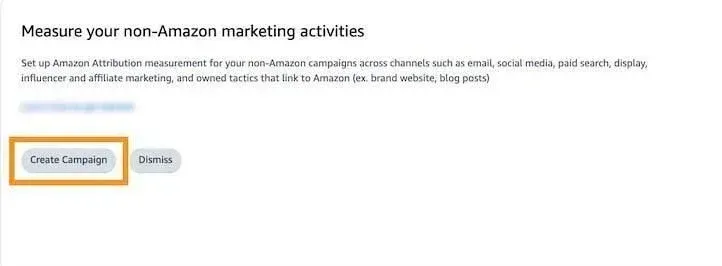
Choose your creation method. You have the option to create a campaign or bulk-generate tags manually.
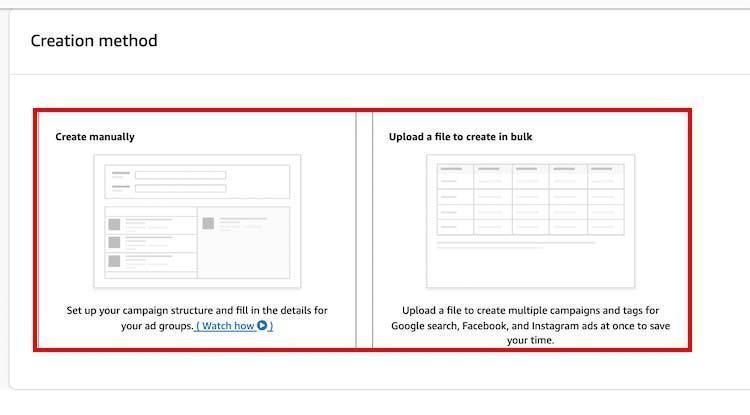
If you manually create a campaign, name your campaign and choose the product for which you want to get the attrition tag.
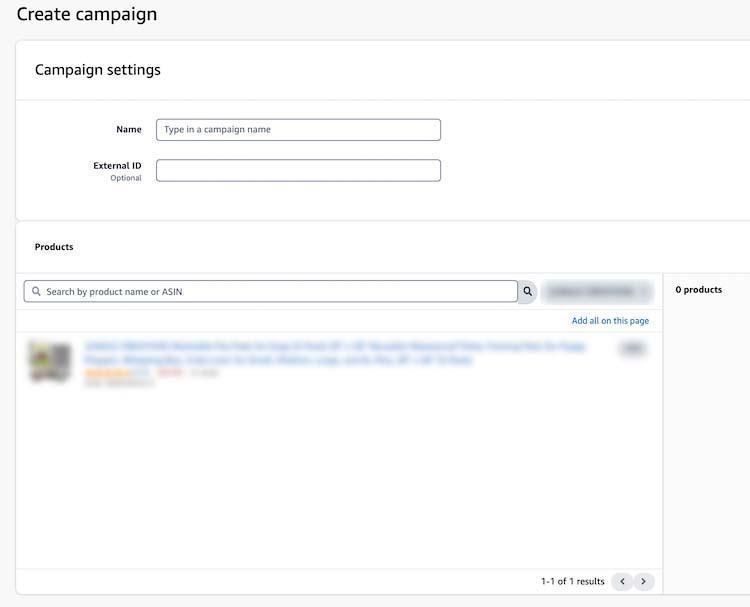
Then, Create a new ad group. In this section, you'll name your ad group, choose a publisher (such as Facebook or Google Ads), and the destination URL.
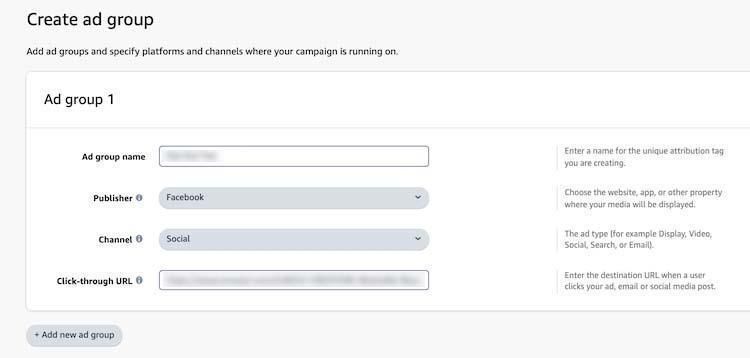
In the right corner, click on 'Create.’
The attribution tag will be created. Use Amazon's attribution link in your advertising so attribution can measure ad performance in external campaigns.
Now you can measure off-Amazon ads efforts. Click "Back to campaigns list" to see all Attribution campaigns.
Now you can measure off-Amazon ads efforts. Click "Back to campaigns list" to see all Attribution campaigns.
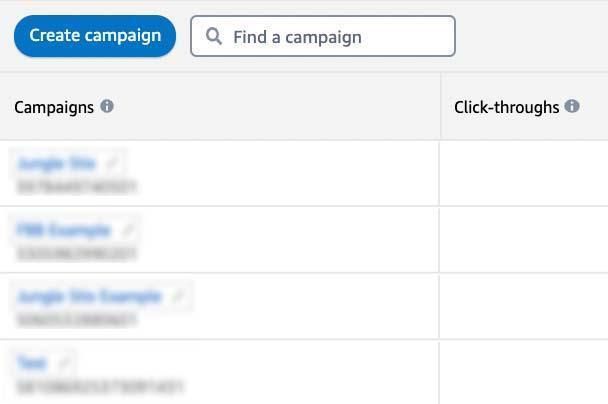
Visit here to watch Amazon’s video on setting up the attribution tag.
How to create cases in Amazon Seller Central?
You can reach out to Amazon support if you come across any inventory system errors or you want to initiate a complaint, or request an investigation, compensation, or other assistance. It’s a simple process.
To open a case, sign in to your Amazon seller account and click "Help."
In the bottom box, click "Contact Us."
On the next page, you will see, 'What service can we help you with?
Click "Selling on Amazon" to see the topics related to a seller.
You can then explore the list of topics to find a particular problem you are facing.
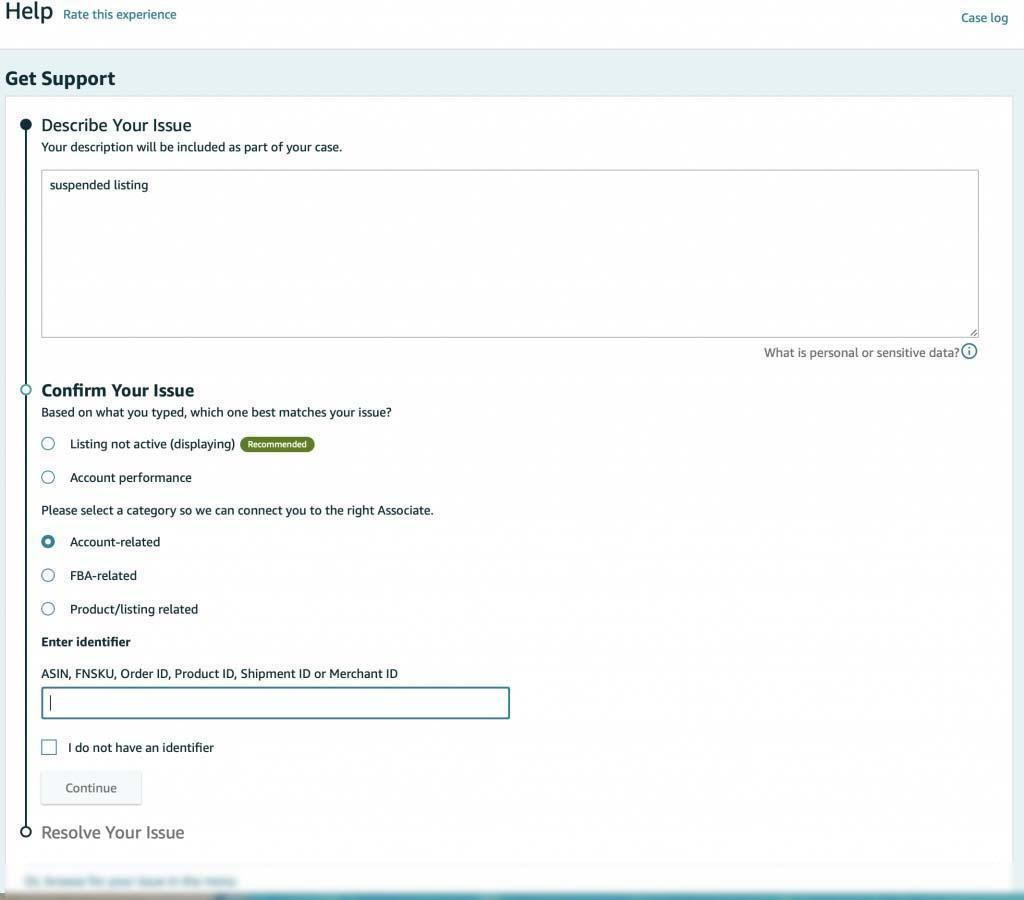
And you can call or send them an email describing your issue.
Benefits of Amazon Attribution
Join Amazon Brand Registry to receive better brand content (A+ Content), brand shops, and more advertising opportunities, all of which can boost sales.
Detailed Performance Insights: It provides granular data on metrics like clicks, views, and conversions from external marketing efforts.
Optimize Marketing Strategies: Sellers can use these insights to optimize their off-Amazon marketing tactics, allocating resources more effectively to the most impactful channels.
Enhanced Understanding of Customer Journey: Amazon Attribution helps understand the customer journey from initial engagement to purchase, enabling sellers to tailor their marketing approaches accordingly.
Data-Driven Decisions: The feature supports data-driven decision-making, allowing sellers to refine their advertising campaigns based on concrete performance data.
Accessing and Using Amazon Attribution:
Eligibility and Access: Amazon Attribution is available to professional sellers enrolled in the Amazon Brand Registry, vendors, and agencies with clients selling on Amazon. Access it by logging into your Seller Central account and navigating to the ‘Advertising’ tab.
Setting Up Attribution Tags: Create attribution tags for your marketing campaigns. These tags are unique tracking parameters you add to your off-Amazon campaign URLs. When a customer clicks on these URLs and purchases your product on Amazon, the action is tracked back to the specific campaign.
Integrating with Marketing Campaigns: Integrate these attribution tags into your various marketing campaigns across channels like social media ads, search engine marketing, email campaigns, etc.
Analyzing the Data: Once your campaigns are live, use the Amazon Attribution dashboard to monitor performance metrics. This data includes impressions, click-through rates, detailed page views, and purchase rates.
Optimizing Campaigns: Use the insights from Amazon Attribution reports to tweak and optimize your marketing strategies. Focus on channels and tactics that show the highest return on investment.
Amazon Attribution Best Practices:
Regularly Monitor Campaign Performance: Check your attribution reports regularly to stay updated on how each marketing channel performs.
Test Different Marketing Channels: Experiment with marketing channels and strategies to understand what works best for your products.
Combine with Amazon’s Internal Tools: Leverage Amazon Attribution alongside internal Amazon advertising tools like Sponsored Products for a comprehensive marketing strategy.
Stay Updated: Keep up with new features and updates to Amazon Attribution to make the most of this tool.
How Do You Initiate a Refund on Amazon Seller Central?
A customer returns an item and requests a refund on Amazon. Many things might cause this:
The buyer may have changed their mind.
Damaged item
It may be different from the description.
Amazon emails you when a consumer requests a refund.
The refund request deadline is 48 hours. If not, the return is automatic.
Go to Amazon Seller Central and find the order. Then click "Refund" and enter the refund amount.
Select "Issue Return" again to confirm the refund amount. After seller clearance, customers will get refunds within 3-5 business days.
How to get sales reports on Amazon Seller Central
Amazon's built-in analytics tool provides accurate and thorough information.
Locate the Reports tab On your Amazon Seller Profile and click the Business Reports option.
Locate the Reports tab On your Amazon Seller Profile, and click the Business Reports option.
It will send you to the primary sales dashboard, where you can check your sales potential and feedback from the primary sales dashboard.
It will take you to the main sales dashboard, where you can see your sales potential and feedback.
Choose your particular period: a day, week, or month for more detailed results.
Optimizing Amazon Seller Central
When you speak of visibility, optimizing your Amazon seller central for SEO is essential to let the Amazon algorithm rank your products on top. Understandably, customers tend to buy products that get ranked higher or on the first page of search results. Following are some SEO tips that you can leverage to optimize your product page.
Keyword Research
Customers search for products using specific key phrases or related terms to find a product. For example, if customers search for "Yoga mat," they might use the words exercise mat or fitness mat. Though the customer is looking for a Yoga mat, he might also search for related terms. If you optimize the keywords solely for Yoga mats, your products appear outside the search results for related terms.
Determine Your Product's Most Important Aspects
Describe its most distinct features and its uses. Consider how it differs from similar products or how buyers may describe it. Some characteristics may be "stainless steel," "water bottle," "insulated," and "leak-proof" if you were selling a stainless-steel water bottle.
Develop catchy slogans by condensing your product's key selling points into simple keywords. For example, if you’re selling a water bottle, you can use terms such as "insulated water bottle," "leak-proof water bottle," and "stainless steel water bottle."
Put yourself in your client's shoes: Consider the terms people in your target market could use to find your goods online. How would they describe it? Think like them and make a list of possible search phrases.
Consider other terms to describe the product or feature; there may be plenty. Similar words that mean "water bottle" include "flask," "thermos," and "canteen." Include these variants in your initial set of seed keywords.
Your seed keywords should be simple and between one and three words long. While searching for long-tail keywords, you'll need to use more extensive phrasing.
Use Amazon's Auto-suggest Function
Enter your seed keywords into the Amazon search field and note the suggested results. These auto-suggestions are based on the most popular searches by users and can shed light on related long-tail keywords (longer, more specific phrases).
Evaluate competitor's listings by looking up similar goods on Amazon and reading the headlines, bullet points, and descriptions. Look for regular expressions and words that they employ since this may reveal their significance. Avoid, however, directly replicating the listings of your rivals.
Employ Keyword Research Tools
Several third-party tools are available for Amazon keyword research, including Helium 10, Jungle Scout, and Sonar. These tools can assist you in locating popular and pertinent keywords, along with information on search traffic and competitiveness.
Try Google Keyword Planner
Google Keyword Planner can provide more information about what people are searching for about your product. Input your seed keywords and examine the recommended terms, concentrating on those with a high search volume and relevance to your offering.
Evaluate and Prioritize Keywords
After compiling a list of possible keywords, evaluate each one for its usefulness, search volume, and level of competition. Focusing on keywords with a large search volume and low competition is essential.
Long-tail keywords are longer, more precise phrases that may have lower search traffic but great conversion rates. With the aid of these keywords, you may cater to a narrower audience and get higher search engine rankings.
How to increase sales on Amazon Seller Central?
Competitive Pricing
Study the prices of your rivals and raise your own. If you want to improve your Amazon business, consider using Amazon's Automate Pricing tool or third-party repricing software to alter your rates automatically depending on competition and sales targets.
Provide promotions and bargains, like discounts, coupons, or buy-one-get-one-free deals, to draw customers and boost sales. Take advantage of Amazon's Lightning Deals or other specials during busy shopping seasons like Prime Day, Black Friday, and Cyber Monday.
Use Amazon Advertising
Invest in Amazon-sponsored items, sponsored brands, or sponsored display campaigns to promote your products and boost sales. Maintain a regular monitoring schedule and make necessary adjustments to your efforts.
Emphasis on customer service: Respond immediately to consumer inquiries and resolve problems to provide excellent customer service. Positive feedback and repeat business may result from this.
Use Fulfillment by Amazon (FBA)
Utilizing FBA can boost product exposure and your chances of snagging the Buy Box. Faster shipment times and improved customer service are two additional benefits of using FBA, which may boost business.
Enhance product selection by conducting regular product portfolio reviews and considering adding new, in-demand items or expanding your current product line. Maintain relevance and competitiveness by keeping up with market developments and client preferences.
Improve inventory management to prevent stockouts from hurting your product rankings and sales. Track and plan your inventory using Amazon's built-in capabilities or a separate piece of software.
Winning the Buy Box for Amazon Sellers
The Buy Box hugely influences Amazon sales. A Buy Box on Amazon is the prominent and convenient "Add to Cart" or "Buy Now" button on product listings. It lets customers make quick purchases from a specific seller, typically offering the best price, shipping options, and customer service. Keep your prices competitive, keep your seller performance metrics high, and consider leveraging FBA to improve your chances of winning the buy box.
Evaluate and Optimize Performance
Regularly analyze your sales statistics, customer feedback, and advertising performance to find areas for improvement. Make better and well-informed judgments and fine-tune your tactics with this data.
Learning in and out of the Amazon seller is the best you can do when new to the platform. But learning the entire Amazon Seller Central in one go is impossible. Also, you can leverage the Amazon Seller University and enroll in courses related to inventory management, dropshipping, and listing products on Amazon stores to learn more about it.
You need some time to stabilize and build a sustainable business on Amazon Seller Central. Considering this, the other business routines, like staying updated on your bookkeeping, take a significant portion of precious time.
How to Advertise on Amazon?
Advertising on Amazon is a powerful way to boost your product visibility and drive more sales. This section covers essential topics such as advertising books, cost strategies, and using Amazon Seller Central for your advertising efforts.
Advertising Books on Amazon
Select the Right Format: Decide between Sponsored Products, Sponsored Brands, or Amazon Display Ads, depending on your book's genre, target audience, and marketing goals.
Targeting Keywords: Use relevant keywords for your book, including genre-specific, theme, and competitive author or title keywords.
Creating Compelling Ads: Design eye-catching ads with compelling copy that highlights the unique aspects of your book.
Utilizing Amazon Marketing Services (AMS): AMS offers tools like Amazon Lockscreen Ads and Sponsored Products that benefit authors and publishers.
Cost Strategies for Amazon Advertising:
Understanding Cost Models: Familiarize yourself with the cost-per-click (CPC) model, where you pay for each click on your ad and set a budget that aligns with your marketing goals.
Budgeting: Determine your daily or campaign budget based on your marketing objectives and the competitive landscape of your product category.
Bid Optimization: Regularly review and adjust your bids based on ad performance, focusing on high-performing keywords and ad placements.
Measuring ROI: Track your advertising cost of sales (ACoS) and return on ad spend (RoAS) to understand the effectiveness of your campaigns.
Using Amazon Seller Central for Advertising:
Accessing the Advertising Dashboard: Within Amazon Seller Central, access the advertising section to create, manage, and optimize your ad campaigns.
Campaign Creation: Start by setting up your campaign type (Sponsored Products, Sponsored Brands, etc.), selecting your products, and defining your target audience.
Keyword Research: Use Amazon’s keyword tools to find high-performing keywords. Consider both broad and long-tail keywords for better targeting.
Ad Optimization: Regularly analyze your ad performance data in Seller Central to optimize ad placements, bids, and keyword targeting.
Leveraging Amazon’s Reporting Tools: Utilize Amazon’s detailed reporting features to gain insights into customer behavior, ad performance, and market trends.
5 Quick Tips for Effective Amazon Advertising:
Start Small and Scale: Begin with a modest budget to test different strategies and then scale your advertising based on what works.
Focus on Product Listings: Ensure your product listings are optimized with high-quality images and detailed descriptions before you start advertising.
Stay Updated: Keep abreast of changes in Amazon’s advertising policies and tools to maximize the impact of your campaigns.
A/B Testing: Experiment with ad creatives, headlines, and keywords to determine what resonates best with your target audience.
Monitor Competitors: Monitor your competitors' advertising strategies to identify opportunities and refine your approach.
How to Search by Seller on Amazon?
To find a seller, you can identify their store on a product's page, use the search bar with accurate spelling, or navigate through department lists. Once found, their storefront showcases products, ratings, and contact details.
Contacting an Amazon seller serves various purposes. It allows collaboration opportunities, such as bundling products or joint marketing efforts, aiding exposure and profitability. Sellers also engage in product sourcing, exploring wholesale purchases, or gathering competitive intelligence on pricing and market trends.
Intellectual property concerns, like trademark infringements, require reaching out to protect brand integrity. Also, resolving order issues, such as shipping errors, is vital for customer satisfaction.
To contact a seller, visit the product page, access the seller's profile, and click the "Ask a question" button. Compose a clear message, hit "Send Message," and await their response in your Amazon account's messaging system.
In summary, contacting Amazon sellers aids collaboration, sourcing, competitive analysis, intellectual property protection, and order issue resolution. Multiple methods simplify finding sellers, ensuring effective communication and informed decisions.
Amazon Manage Orders: Navigating Amazon Seller Central
Managing orders is crucial for success on Amazon’s platform, especially for sellers using Amazon Seller Central. This guide provides detailed instructions and tips on managing orders, ensuring efficient order processing, and troubleshooting common issues.
Detailed Guidance on Managing Orders in Amazon Seller Central:
Accessing Order Management: Log in to your Amazon Seller Central account. Navigate to the 'Orders' tab. Here, you will find options like 'Manage Orders', 'Order Reports,' and 'Advanced Order Management.'
Viewing and Processing Orders: Under 'Manage Orders,' you can see a list of your current orders. This section provides details like order status, buyer information, and shipping details. You can update the status of orders as you process them.
Handling Order Modifications: If a customer requests an order modification, you can make changes before the order is shipped. It includes updating quantities, adding or removing items, or canceling orders.
Managing Returns and Refunds: Returns and refunds are a part of online selling. In Seller Central, navigate to the 'Return Requests' section to manage and process returns and issue refunds when necessary.
Using Order Reports: For detailed insights, use the 'Order Reports' feature to generate reports for a comprehensive overview of your orders over a selected period.
Tips for Efficient Order Management:
Regularly Check Orders: Check your 'Manage Orders' section to stay updated on new orders, changes, or any pending actions required from your end.
Set Up Order Notifications: Enable email or mobile notifications to get alerted about new orders or changes, helping you to respond quickly.
Organize Your Orders: Use filters and sorting options to organize orders based on criteria like order date, fulfillment method, or status. It helps in prioritizing and managing orders more effectively.
Automate Processes: Consider using automation tools available in Seller Central for tasks like order confirmations, tracking updates, and feedback requests to streamline your workflow.
Stay Informed on Policies: Regularly update yourself on Amazon’s policies regarding order management, shipping, returns, and refunds to avoid policy violations.
Troubleshooting Common Issues:
Delayed Shipments: If you face issues with delayed shipments, communicate proactively with the customer and update the order status accordingly. Explore expedited shipping options if necessary.
Inventory Discrepancies: Regularly reconcile your inventory to ensure the quantities listed on Amazon match your stock to avoid order cancellations due to stockouts.
Customer Complaints: Address customer complaints promptly. Use the 'Buyer-Seller Messages' feature in Seller Central for direct customer communication.
Technical Glitches: If you encounter technical issues in Seller Central, use the 'Help' section or contact Amazon Seller Support for assistance.
Amazon Hub Locker: Urban Logistics and Distribution
Amazon's approach to logistics and distribution in central square areas, such as busy urban centers or popular public spaces, is a crucial aspect of their strategy to streamline the online shopping experience. Central squares are vital hubs of activity, and Amazon capitalizes on this by providing convenient and efficient solutions like the Amazon Hub Locker. Let's explore how this service enhances the urban shopping and delivery experience.
Amazon Hub Locker Central Square:
Secure and Convenient Package Pickup: Amazon Hub Lockers are self-service kiosks in central square areas where customers can securely pick up their Amazon packages at their convenience. This service is beneficial for those away from home to receive deliveries.
Easy Accessibility: Located in central squares, these lockers are often near transit points, shopping areas, or other well-visited locations, making them easily accessible.
24/7 Availability: Many Amazon Hub Lockers in central square areas are accessible 24/7, allowing customers to pick up their packages anytime, which is ideal for busy urban lifestyles.
Simple Return Process: These lockers are not just for package pickup; they also simplify the return process. Customers can drop off their returns at these lockers, making it a hassle-free experience.
Amazon Hublocker’s Impact on Urban Distribution:
Efficiency in High-Density Areas: By utilizing central square locations, Amazon enhances the efficiency of deliveries in high-density urban areas.
Customer Convenience: The strategic placement of Amazon Hub Lockers in these areas serves the dual purpose of convenience for customers and efficiency for Amazon’s logistics.
Alleviating Traffic and Pollution: Amazon reduces traffic congestion and pollution in urban centers with localized distribution centers and eco-friendly vehicles.
Most emerging or successful Amazon sellers will use QuickBooks or Xero for their accounting needs. Suppose they closely tie online sales and transactions into QuickBooks from any e-commerce platform or payment gateway. In that case, PayTraQer will be a great addition to their online app garage as it automatically syncs them into QuickBooks and Xero. Complete transaction synchronization within minutes and focus on your core business goals.
If you want to know more about Amazon selling without inventory, read how to sell on Amazon without inventory.
Frequently Asked Questions
What is Amazon Seller App, and how do I register on it?
The Amazon Seller App is a mobile application provided by Amazon that allows individuals and businesses to manage their selling accounts and products on the Amazon platform. It's a powerful tool for sellers to monitor their sales, track inventory, respond to customer messages, and manage their listings, among other essential tasks.
Here's how you can register on the Amazon Seller App:
Download the App: Visit the app store on your mobile device (App Store for iOS devices or Google Play Store for Android devices) and search for "Amazon Seller." Download and install the app on your device.
Open the App: Once installed, open it on your device.
Sign Up or Log In
You can log in using your existing credentials if you already have an Amazon Seller account.
If you don't have an Amazon Seller account, you must sign up for one. Click the "Register Now" or "Create your Amazon Seller account" option. Follow the on-screen instructions to set up your seller account.
Provide Business Information
You must provide your business information, including your name, address, contact details, and tax information.
You may need to verify your identity and bank account information to receive payments from your sales.
Accept Amazon's Terms and Conditions: Review Amazon's seller terms and conditions, and if you agree, accept them to proceed.
Complete Registration: Once you've provided all the required information and accepted the terms, your registration process will be complete. You'll then have access to the Amazon Seller App.
Start Selling: You can now start listing your products, managing your inventory, and monitoring your sales through the app.
How do I activate my Amazon Seller account?
Activating your Amazon Seller account is essential to kickstart your selling journey on the platform. Here's a quick overview of the steps:
Complete Registration: Visit the Amazon Seller website, provide necessary business and contact details, and agree to Amazon's Seller Agreement.
Verify Email: Check your email for a verification link from Amazon and click to confirm your email address.
Provide Identity and Tax Info: Submit the required identity and tax documents depending on your location and products.
Choose a Marketplace: Select the Amazon marketplace where you want to sell and create your first product listing.
Set Up Payments: Configure your preferred payment methods for receiving sales proceeds.
Start Selling: Once activated, manage your inventory and sell on Amazon through Seller Central or the Amazon Seller App. Happy selling!
Is the Amazon Seller App free, or does it come with an additional cost?
The Amazon Seller app is available at no additional cost. Download the free Amazon Seller App from the Apple Store or Google Play. Once you log in, you can manage business details right from your mobile device.
How do I register on Amazon Seller Central, and what are the selling plan options?
To register, go to Amazon Seller Central and select either the Individual Selling Plan (suitable for lower seller volumes with a per-sale fee) or the Professional Selling Plan (recommended for professional sellers with a monthly fee). You'll need to provide tax, banking, and other essential information.
How can I optimize my product listings on Amazon Seller Central for better visibility and sales?
Conduct keyword research, use Amazon's auto-suggest function to optimize your product listings, employ keyword research tools, and prioritize keywords. Focus on competitive pricing, provide promotions, use Amazon advertising, offer excellent customer service, and consider using Fulfillment by Amazon (FBA) to enhance your sales on Amazon Seller Central.
How do I manage product prices in Amazon Seller Central?
You can manage product prices in Amazon Seller Central by going to the "Inventory" tab, selecting "Manage inventory," and clicking the "Edit" button for the product you want to edit. You can then adjust the pricing details.
How do I fulfill seller-fulfilled orders (FBM) on Amazon Seller Central?
To fulfill seller-fulfilled orders, go to "Manage Orders" under the "Orders" page in Amazon Seller Central. Here, you can view and manage your orders, including those you fulfilled.
What is Amazon Attribution, and how can I set it up in Seller Central?
Amazon Attribution is a tool that helps you evaluate external advertising performance. To set it up, visit Amazon Seller Central, go to Amazon Attribution, create a new campaign, and follow the steps to generate an attribution tag used in your external marketing campaigns.
How do I create cases in Amazon Seller Central for support or inquiries?
You can create cases in your Amazon Seller Central account by clicking "Help," selecting "Contact Us," and choosing the relevant topic for your inquiry. You can then contact Amazon seller support for assistance.
How to start an Amazon account?
To start an Amazon account, visit Seller Central, click "Register Now," and choose between an Individual or Professional account. Provide your business details, agree to Amazon's terms, verify your email, and complete any required tax interviews. Select your desired marketplace, add product listings, set up payment methods, and you're ready to begin selling on Amazon's platform.
How do I access Amazon Seller Central Customer Service?
Log in to your Seller Central account to access customer service in Amazon Seller Central. Navigate to the 'Help' section, typically found at the top right corner of the dashboard. Here, you will find various resources, including contact options for customer service. You can contact Amazon Seller Central Customer Service through email, phone, and live chat. Contact options are displayed in the Help section once logged into your Seller Central account.